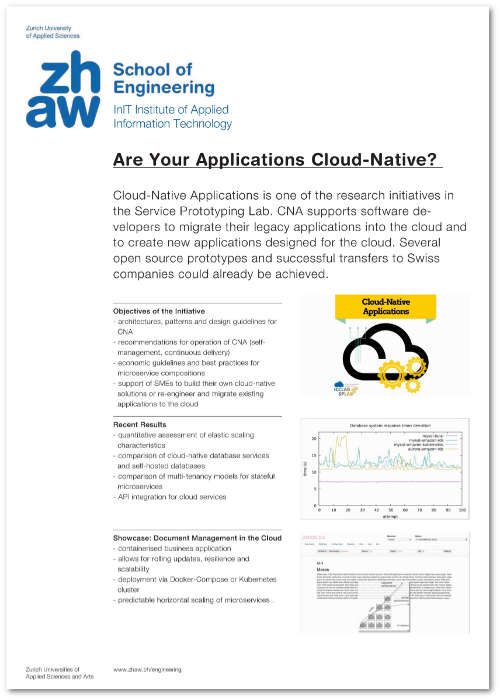Since Amazon started offering cloud services (AWS) in 2006, cloud computing in all its forms became evermore popular and has steadily matured since. A lot of experience has been collected and today a high number of companies are running their applications in the cloud either for themselves or to offer services to their customers. The basic characteristics of this paradigm1 offer capabilities and possibilities to software applications that were unthinkable before and are the reason why cloud computing was able to establish itself the way it did.
What is a Cloud-Native Application?
In a nutshell, a cloud-native application (CNA) is a distributed application that runs on a cloud infrastructure (irrespective of infrastructure or platform level) and is in its core scalable and resilient as well as adapted to its dynamic and volatile environment. These core requirements are derived from the essential characteristics that every cloud infrastructure must by definition possess, and from user expectations. It is of course possible to run an application in the cloud that doesn’t meet all those criteria. In that case it would be described as a cloud-aware or cloud-ready application instead of a cloud-native application. Through a carefully cloud-native application design based on composed stateful and stateless microservices, the hosting characteristics can be exploited so that scalability and elasticity do not translate into significantly higher cost.
Objectives
- The CNA initiative provides architecture and design guidelines for cloud-native applications, based on lessons-learned of existing applications and by taking advantage of best-practices (Cloud-Application Architecture Patterns).
- Evaluate microservice technology mappings, related to container compositions, but also other forms of microservice implementations.
- Provide recommendations for operation of cloud native applications (Continuous Delivery, Scaling, Monitoring, Incident Management,…)
- Provide economic guidelines on how to operate cloud native applications (feasibility, service model (mix), microservice stacks, containers, …)
- Investigate in, develop and establish a set of open source technologies, tools and services to build, operate and leverage state of the art cloud-native applications.
- Support SMEs to build their own cloud-native solutions or reengineer and migrate existing applications to the cloud.
- Ensure that all new applications developed within the SPLab and the ICCLab are cloud-native.
Relevance to current and future markets
- Using cloud infrastructures (IaaS/PaaS) it is possible to prototype and test new business ideas quickly and without spending a lot of money up-front.
- An application running on a cloud infrastructure – if designed in a cloud-native way – only ever uses as many resources as needed. This avoids under- or over- provisioning of resources and ensures cost-savings.
- Developing software with services offered by cloud infrastructure and -platform providers enables even a small team to create highly scalable applications serving a high number of customers.
- Developing cloud-native applications with a microservice architecture style allows for shorter development-cycles which reduces the time to adapt to customer feedback, new customer requirements and changes in the market.
- Cloud-native applications are tightly bound to cloud computing resp. to IaaS and PaaS since these technologies are used to develop and host applications and in the best case these applications are cloud native. So wherever these technologies stand in the Gartner Hype-Cycle Cloud-Native Applications can be thought of as being at the same stage.
-
The Cloud-Native Computing Foundation (CNCF.io) and other industry groups are formed to shape the evolution of technologies that are container packaged, dynamically scheduled and microservices oriented.
-
Container composition languages and tools are on the rise. A careful evaluation and assessment of technologies, lock-ins, opportunities is required. The CNA initiative brings sufficient academic rigor to afford long-term perspectives on these trends.
For more information, contact us for assistance on your way to cloud-native software development.
